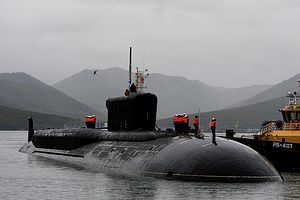The Russian Navy will launch the first advanced variant of the nuclear-powered ballistic missile submarine (SSBN) Project 955A Borei II-class (“North Wind”) aka Dolgorukiy-class in August, the head of the Russian Navy, Admiral Vladimir Korolyov, announced on June 26 in Saint Petersburg, Russia.
The new boomer, christened Knyaz Vladimir (Prince Vladimir), will strengthen Russia’s sea-based nuclear deterrent, according to the admiral. “In August this year, the Severodvinsk-based Sevmash Shipyard will flout out the new Borei-class strategic underwater cruiser, the Prince Vladimir, which will strengthen the potential of the nuclear component of the Navy’s submarine fleet,” he said, TASS news agency reports.
The Knyaz Vladimir, the lead boat of the improved Borei II-class, was laid down in July 2012 at the Sevmash Shipyards in Severodvinsk, a port city on Russia’s White Sea, following a two year delay due to contract disputes between the Russian Ministry of Defense and the ship contractor, which pushed back the commissioning date of the ship from 2017 to 2018. The likely 2018 commissioning date was confirmed by Vice Admiral Viktor Bursuk, the deputy commander of the Russian Navy, in March.
The major difference between the Borei and Borei II-class is the latter’s capability to carry a much bigger nuclear payload, as I noted elsewhere (See: “Russia Will Start Constructing New Ballistic Missile Submarine in December”):
In comparison to the Borei-class, Borei II-class submarines are fitted with four additional missile tubes, boast smaller hulls and cons, and feature improved acoustics and lower sound levels, next to a number of other technical improvements.
Both variants of Borei-class subs will be armed with Bulava (RSM-56) intercontinental ballistic missiles (ICBMs). The Borei-class will be capable of carrying up to 16 Bulava ICBMs, whereas the improved Borei II-class can carry up to 20 ballistic missiles.
The improved variant of the Borei-class will be capable of launching 96-200 hypersonic, independently maneuverable warheads, yielding 100-150 kilotons apiece.
The Russian Navy plans to operate eight Borei-class SSBNs–three Borei-class and five improved Borei II-class boats–by 2o25. As of new, three Borei-class SSBNs have been commissioned to date with one submarine, the Yuri Dolgoruky, serving with the Northern Fleet and the remaining two–Alexander Nevsky and Vladimir Monomakh—deployed with Russia’s increasingly more active Pacific Fleet.
Next, to announcing the launch of the Knyaz Vladimir, Admiral Korolyov also told reporters on June 26 that Russia is developing a next-generation nuclear-powered submarines. “Along with this, work is already under way to develop fifth-generation nuclear-powered submarines,” the admiral said.
As I reported in June 2015, the new sub class will likely consist of two variants specifically designed for anti-submarine warfare and anti-surface warfare missions. “The main purpose of the [underwater interceptor] is to protect groups of [ballistic] missile carrying submarines, and to battle with enemy submarines. The second ship will be a cruise missile carrier [used] for defeating coastal and surface targets,” a senior Russian defense industry official said at the time.

































